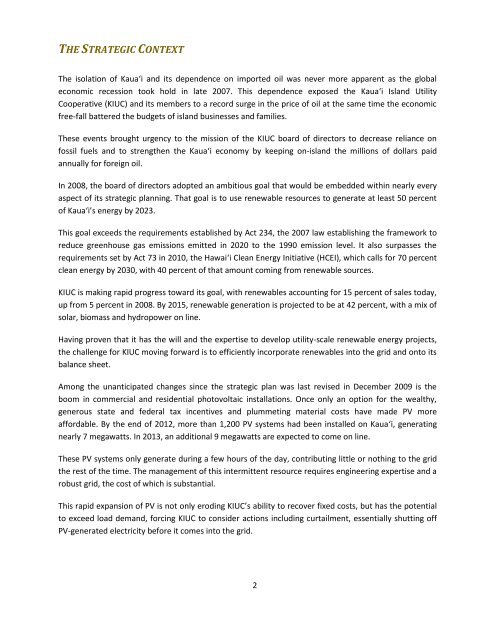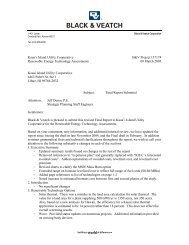draft of the plan - Kauai Island Utility Cooperative
draft of the plan - Kauai Island Utility Cooperative
draft of the plan - Kauai Island Utility Cooperative
You also want an ePaper? Increase the reach of your titles
YUMPU automatically turns print PDFs into web optimized ePapers that Google loves.
THE STRATEGIC CONTEXT<br />
The isolation <strong>of</strong> Kauaʻi and its dependence on imported oil was never more apparent as <strong>the</strong> global<br />
economic recession took hold in late 2007. This dependence exposed <strong>the</strong> Kauaʻi <strong>Island</strong> <strong>Utility</strong><br />
<strong>Cooperative</strong> (KIUC) and its members to a record surge in <strong>the</strong> price <strong>of</strong> oil at <strong>the</strong> same time <strong>the</strong> economic<br />
free-fall battered <strong>the</strong> budgets <strong>of</strong> island businesses and families.<br />
These events brought urgency to <strong>the</strong> mission <strong>of</strong> <strong>the</strong> KIUC board <strong>of</strong> directors to decrease reliance on<br />
fossil fuels and to streng<strong>the</strong>n <strong>the</strong> Kauaʻi economy by keeping on-island <strong>the</strong> millions <strong>of</strong> dollars paid<br />
annually for foreign oil.<br />
In 2008, <strong>the</strong> board <strong>of</strong> directors adopted an ambitious goal that would be embedded within nearly every<br />
aspect <strong>of</strong> its strategic <strong>plan</strong>ning. That goal is to use renewable resources to generate at least 50 percent<br />
<strong>of</strong> Kauaʻi’s energy by 2023.<br />
This goal exceeds <strong>the</strong> requirements established by Act 234, <strong>the</strong> 2007 law establishing <strong>the</strong> framework to<br />
reduce greenhouse gas emissions emitted in 2020 to <strong>the</strong> 1990 emission level. It also surpasses <strong>the</strong><br />
requirements set by Act 73 in 2010, <strong>the</strong> Hawaiʻi Clean Energy Initiative (HCEI), which calls for 70 percent<br />
clean energy by 2030, with 40 percent <strong>of</strong> that amount coming from renewable sources.<br />
KIUC is making rapid progress toward its goal, with renewables accounting for 15 percent <strong>of</strong> sales today,<br />
up from 5 percent in 2008. By 2015, renewable generation is projected to be at 42 percent, with a mix <strong>of</strong><br />
solar, biomass and hydropower on line.<br />
Having proven that it has <strong>the</strong> will and <strong>the</strong> expertise to develop utility-scale renewable energy projects,<br />
<strong>the</strong> challenge for KIUC moving forward is to efficiently incorporate renewables into <strong>the</strong> grid and onto its<br />
balance sheet.<br />
Among <strong>the</strong> unanticipated changes since <strong>the</strong> strategic <strong>plan</strong> was last revised in December 2009 is <strong>the</strong><br />
boom in commercial and residential photovoltaic installations. Once only an option for <strong>the</strong> wealthy,<br />
generous state and federal tax incentives and plummeting material costs have made PV more<br />
affordable. By <strong>the</strong> end <strong>of</strong> 2012, more than 1,200 PV systems had been installed on Kauaʻi, generating<br />
nearly 7 megawatts. In 2013, an additional 9 megawatts are expected to come on line.<br />
These PV systems only generate during a few hours <strong>of</strong> <strong>the</strong> day, contributing little or nothing to <strong>the</strong> grid<br />
<strong>the</strong> rest <strong>of</strong> <strong>the</strong> time. The management <strong>of</strong> this intermittent resource requires engineering expertise and a<br />
robust grid, <strong>the</strong> cost <strong>of</strong> which is substantial.<br />
This rapid expansion <strong>of</strong> PV is not only eroding KIUC’s ability to recover fixed costs, but has <strong>the</strong> potential<br />
to exceed load demand, forcing KIUC to consider actions including curtailment, essentially shutting <strong>of</strong>f<br />
PV-generated electricity before it comes into <strong>the</strong> grid.<br />
2

















